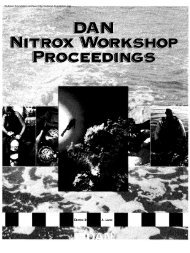dan avoiding ear & sinus injuries in scuba - Divers Alert Network
dan avoiding ear & sinus injuries in scuba - Divers Alert Network
dan avoiding ear & sinus injuries in scuba - Divers Alert Network
You also want an ePaper? Increase the reach of your titles
YUMPU automatically turns print PDFs into web optimized ePapers that Google loves.
THE UPS AND DOWNS OF DIVING.<br />
STUDENTS<br />
GUIDE<br />
DAN AVOIDING EAR & SINUS INJURIES IN SCUBA DIVING<br />
TO AVOID BAROTRAUMA, REMEMBER:<br />
• Test the <strong>ear</strong>s and <strong>s<strong>in</strong>us</strong>es by equaliz<strong>in</strong>g prior to enter<strong>in</strong>g the water or prior to<br />
your descent;<br />
• Descend at a slow, steady pace, and keep up with your cl<strong>ear</strong><strong>in</strong>g maneuvers;<br />
• Do not cont<strong>in</strong>ue to descend or forcefully cl<strong>ear</strong> if you’re hav<strong>in</strong>g difficulty<br />
— stop your descent before you experience <strong>ear</strong> or <strong>s<strong>in</strong>us</strong> pa<strong>in</strong> (wait<strong>in</strong>g until you<br />
feel discomfort to beg<strong>in</strong> cl<strong>ear</strong><strong>in</strong>g means that you’ve waited too long);<br />
• Descend and equalize <strong>in</strong> a feet-first position; it is easier than head-first;<br />
• If you do experience pa<strong>in</strong> or discomfort, ascend until it is relieved;<br />
• Equalize <strong>ear</strong>ly and often to stay “ahead” of barotrauma.<br />
DIFFICULTY EQUALIZING<br />
What if you can’t equalize? First, don’t dive until the problem is resolved. If a diver<br />
has trouble equaliz<strong>in</strong>g the <strong>s<strong>in</strong>us</strong>es and middle <strong>ear</strong>, there may be some pre-exist<strong>in</strong>g<br />
problem — the most common is div<strong>in</strong>g with a cold or flu. Frequently, the mucous<br />
membrane will reta<strong>in</strong> fluid and swell, partially occlud<strong>in</strong>g the air passages to your<br />
<strong>s<strong>in</strong>us</strong>es and the Eustachian tube go<strong>in</strong>g from the back of your throat to the middle<br />
<strong>ear</strong>. This not only makes cl<strong>ear</strong><strong>in</strong>g difficult, but it also may prevent it altogether. Other<br />
recognizable factors <strong>in</strong> equaliz<strong>in</strong>g problems are:<br />
• A history of childhood <strong>ear</strong> <strong>in</strong>fections or even one severe <strong>in</strong>fection that may<br />
leave the Eustachian tube scarred and partially occluded;<br />
• A history of a broken nose or a deviated septum that prevents one <strong>ear</strong> or set of<br />
<strong>s<strong>in</strong>us</strong>es from cl<strong>ear</strong><strong>in</strong>g as quickly as the opposite side;<br />
• Allergies, which may produce swell<strong>in</strong>g of the mucous membranes or cause<br />
nasal polyps that can partially or completely occlude a <strong>s<strong>in</strong>us</strong> cavity or airway.<br />
If you have a history that <strong>in</strong>cludes these conditions and want to dive successfully,<br />
it may require referral to an <strong>ear</strong>, nose and throat physician or allergy specialist who<br />
is familiar with these conditions. Nose sprays or oral medications can be used to<br />
shr<strong>in</strong>k swollen mucous membranes and facilitate <strong>s<strong>in</strong>us</strong> and middle <strong>ear</strong> equalization.<br />
4

















